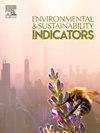Evaluation of sustainable energy use in sugarcane production: A holistic model from planting to harvest and life cycle assessment
IF 5.4
Q1 ENVIRONMENTAL SCIENCES
引用次数: 0
Abstract
The study evaluates energy consumption in sugarcane production at the Salman Farsi Sugarcane Agro-Industrial Company in Khuzestan province, Iran, comparing plant cane and ratoon cycles. Plant cane show higher energy input (124,912.32 MJ ha-1) and output (107,530.44 MJ ha-1) than ratoon farms (80,317.81 MJ ha-1 input and 87,586.68 MJ ha-1 output). However, ratoon cycles are more energy efficient. To lessen energy use in plant cane, the research recommends strategies like minimizing machinery use, adopting reduced and no-tillage practices, and employing efficient irrigation and spraying methods. The environmental assessment reveals that plant cane have greater negative impacts on human health, ecosystems, and resources. Specifically, human health impacts are 3.69 DALY for planted systems versus 1.54 for ratoon systems, indicating greater health risks from initial plantings. Ecosystem impacts also show more local species loss in planted systems (6.25E-04 species.yr compared to 4.11E-04 for ratoon). Moreover, resource costs are higher for planted systems at 320.12 USD2013 of sugarcane, compared to 210.46 USD2013 for ratoon production. The analysis compares Artificial Neural Network and Adaptive Neuro-Fuzzy Inference Systems models for predicting energy outputs and environmental effects. Artificial Neural Network models excel in predicting impacts for planted sugarcane, whereas Adaptive Neuro-Fuzzy Inference Systems models are more accurate for ratoon production and are computationally more efficient. The findings emphasize the need for improved sustainability and efficiency in sugarcane production through better energy management and reduced environmental impacts.
求助全文
约1分钟内获得全文
求助全文
来源期刊

Environmental and Sustainability Indicators
Environmental Science-Environmental Science (miscellaneous)
CiteScore
7.80
自引率
2.30%
发文量
49
审稿时长
57 days
 求助内容:
求助内容: 应助结果提醒方式:
应助结果提醒方式:


